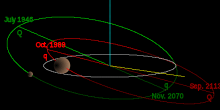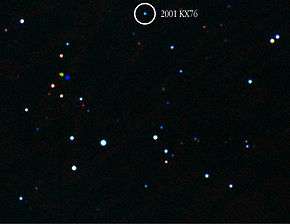28978 Ixion
|
Ixion imaged with the 2.2-meter MPG/ESO telescope at La Silla Observatory in 2001 at a distance of 41 AU | |
| Discovery [1][2] | |
|---|---|
| Discovered by |
Deep Ecliptic Survey Cerro Tololo (807) |
| Discovery date | 22 May 2001 |
| Designations | |
| MPC designation | 28978 Ixion |
| Pronunciation | /ɪkˈsaɪ.ən/ ik-SY-ən [note 1] |
| 2001 KX76 | |
| TNO (plutino)[3] | |
| Adjectives | Ixionian |
| Orbital characteristics [1] | |
| Epoch 13 January 2016 (JD 2457400.5) | |
| Uncertainty parameter 2 | |
| Observation arc | 11665 days (31.94 yr) |
| Aphelion | 49.053 AU (7.3382 Tm) |
| Perihelion | 29.956 AU (4.4814 Tm) |
| 39.505 AU (5.9099 Tm) | |
| Eccentricity | 0.24171 |
| 248.30 yr (90692.7 d) | |
| 280.540° | |
| 0° 0m 14.29s / day | |
| Inclination | 19.619° |
| 71.019° | |
| 299.730° | |
| Earth MOID | 28.9998 AU (4.33831 Tm) |
| Jupiter MOID | 25.2123 AU (3.77171 Tm) |
| Jupiter Tisserand parameter | 5.169 |
| Physical characteristics | |
| Dimensions |
617+19 −20 km [4] |
| 12.4±0.3 h[5] | |
| 0.141±0.011 [4] | |
| Temperature | ≈ 44 K |
|
B−V = 1.03±0.03 V−R = 0.61±0.03 [6] | |
| 19.6 (opposition)[7] | |
| 3.828±0.039, [4] 3.6[1] | |
| 0.022″ | |
28978 Ixion is a plutino (an object that has a 2:3 orbital resonance with Neptune). It is very likely to be a dwarf planet,[8][9] although the IAU has not officially classified it as such. Light-curve-amplitude analysis shows only small deviations, which suggests that Ixion is a spheroid with small albedo spots and hence a dwarf planet.[10] It has a diameter of approximately 650 km, making it about the fifth-largest plutino. It is moderately red in visible light and has a surface made of a mixture of tholin and water ice.
It was discovered on May 22, 2001 by the Cerro Tololo Inter-American Observatory (807).[2] It is named after Ixion, a figure from Greek mythology.
Physical characteristics

Other than Pluto, Ixion was the first trans-Neptunian object (TNO) discovered that was originally estimated to be larger than dwarf planet Ceres,[11] Even in 2002, a year after its discovery, Ixion was still believed to be more than 1000 km in diameter,[12] though the 2002 estimate was a result of a spurious detection at 250 GHz that was not confirmed by later observations.[13] More recent estimates suggest that Ixion has a high albedo[14] and is smaller than Ceres. Observations of Ixion by Herschel Space Telescope and Spitzer Space Telescope in the far-infrared part of the spectrum revealed that its size is about 620 km.[4]
Ixion is moderately red (slightly redder than 50000 Quaoar) in the visible light.[15] It also has a higher albedo (>0.15) than the mid-sized red cubewanos.[13] There may be an absorption feature at the wavelength of 0.8 μm in its spectrum, which is commonly attributed to the alteration of surface materials by water.[15] In the near-infrared the spectrum of Ixion is flat and featureless. Water ice absorption bands at 1.5 and 2 μm are absent. This is in contrast to Varuna, which has a red spectral slope in the near-infrared as well as prominent water absorption bands.[16] Both visible and infrared spectroscopic results indicate that Ixion's surface is a mixture of water ice, dark carbon and tholin, which is a heteropolymer formed by irradiation of clathrates of water and organic compounds.[17] The Very Large Telescope (VLT) has checked Ixion for cometary activity, but did not detect a coma.[18] Ixion is currently about 41 AU from the Sun,[7] and it is possible that Ixion could develop a coma or temporary atmosphere when it is closer to perihelion.
Orbit and rotation

Ixion and Pluto follow similar but differently oriented orbits: Ixion’s perihelion is below the ecliptic whereas Pluto's is above it. Uncharacteristically for bodies locked in resonance with Neptune (such as Orcus), Ixion approaches Pluto with less than 20 degrees of angular separation. Ixion is currently below the ecliptic and will reach its perihelion in 2070. Pluto has passed its perihelion (1989) and is descending toward the ecliptic. Ixion's orbital period is almost 250 Earth years, about 0.5% larger than Pluto's. Ixion does demonstrate some regular changes in brightness, which are thought to be caused by its rotation. As of 2010, however, the rotation period of Ixion remains undetermined.[17]
See also
Notes
- ↑ Or as in Latin: Ixīōn, Ancient Greek: Ιξίων. Sometimes erroneously /ˈɪksiən/ IK-see-ən.
References
- 1 2 3 "JPL Small-Body Database Browser: 28978 Ixion (2001 KX76)". JPL/NASA. 2007-07-12. Retrieved 12 April 2016.
- 1 2 B. G. Mardsen (1 July 2001). "MPEC 2001-N01: 2001 FT185, 2001 KW76, 2001 KX76, 2001 KY76, 2001 KZ76, 2001 KA77". IAU Minor Planet Center. Retrieved 2010-01-06.
- ↑ M. W. Buie (12 July 2007). "Orbit Fit and Astrometric record for 28978". SwRI, Space Science Department. Retrieved 2008-09-29.
- 1 2 3 4 Lellouch, E.; Santos-Sanz, P.; Lacerda, P.; Mommert, M.; Duffard, R.; Ortiz, J. L.; Müller, T. G.; Fornasier, S.; Stansberry, J.; Kiss, Cs.; Vilenius, E.; Mueller, M.; Peixinho, N.; Moreno, R.; Groussin, O.; Delsanti, A.; Harris, A. W. (September 2013). ""TNOs are Cool": A survey of the trans-Neptunian region. IX. Thermal properties of Kuiper belt objects and Centaurs from combined Herschel and Spitzer observations" (PDF). Astronomy & Astrophysics. 557: A60. Bibcode:2013A&A...557A..60L. doi:10.1051/0004-6361/201322047. Retrieved 7 November 2014.
- ↑ Results from the 2016 jun 3 "Photometry of Centaurs and trans- Neptunian objects:2060 Chiron (1977 UB), 10199 Chariklo (1997 CU26),38628 Huya (2000 EB173), 28978 Ixion (2001 KX76), and 90482 Orcus (2004 DW)"
- ↑ Doressoundiram, A.; Peixinho, N.; Moullet, A.; Fornasier, S.; Barucci, M. A.; Beuzit, J. -L.; Veillet, C. (2007). "The Meudon Multicolor Survey (2MS) of Centaurs and Trans-Neptunian Objects: From Visible to Infrared Colors". The Astronomical Journal. 134 (6): 2186. Bibcode:2007AJ....134.2186D. doi:10.1086/522783.
- 1 2 "AstDys (28978) Ixion Ephemerides". University of Pisa, Department of Mathematics. Retrieved 2009-08-13.
- ↑ Michael E. Brown. "How many dwarf planets are there in the outer solar system? (updates daily)". California Institute of Technology. Archived from the original on 2011-10-18. Retrieved 2011-08-25.
- ↑ Tancredi, G. (2010). "Physical and dynamical characteristics of icy "dwarf planets" (plutoids)". Icy Bodies of the Solar System: Proceedings IAU Symposium No. 263, 2009.
- ↑ Tancredi, G., & Favre, S. (2008) Which are the dwarfs in the Solar System?. Depto. Astronomía, Fac. Ciencias, Montevideo, Uruguay; Observatorio Astronómico Los Molinos, MEC, Uruguay. Retrieved 10-08-2011
- ↑ R. Stenger (24 August 2001). "New object deemed largest minor planet". CNN. Retrieved 2008-02-29.
- ↑ F. Bertoldi; W. Altenhoff; N. Junkes (7 October 2002). "Beyond Pluto: Max-Planck radioastronomers measure the sizes of distant minor planets". SpaceRef.com. Retrieved 2010-01-06.
- 1 2 W. J. Altenhoff; F. Bertoldi; K. M. Menten (2004). "Size estimates of some optically bright KBOs". Astronomy and Astrophysics. 415 (2): 771–775. Bibcode:2004A&A...415..771A. doi:10.1051/0004-6361:20035603.
- ↑ W. R. Johnston (17 September 2008). "TNO/Centaur diameters and albedos". Archived from the original on 29 August 2010. Retrieved 28 July 2010.
- 1 2 S. Marchi; M. Lazzarin; S. Magrin; C. Barbieri (2003). "Visible spectroscopy of the two largest known trans–Neptunian objects: Ixion and Quaoar". Astronomy and Astrophysics Letters. 408 (3): L17–L19. Bibcode:2003A&A...408L..17M. doi:10.1051/0004-6361:20031142.
- ↑ J. Licandro; F. Ghinassi; L. Testi (2002). "Infrared spectroscopy of the largest known trans-Neptunian object 2001 KX76". Astronomy and Astrophysics Letters. 388: L9–L12. arXiv:astro-ph/0204104
 . Bibcode:2002A&A...388L...9L. doi:10.1051/0004-6361:20020533.
. Bibcode:2002A&A...388L...9L. doi:10.1051/0004-6361:20020533. - 1 2 H. Boehnhardt; et al. (2004). "Surface characterization of 28978 Ixion (2001 KX76)". Astronomy and Astrophysics Letters. 415 (2): L21–L25. Bibcode:2004A&A...415L..21B. doi:10.1051/0004-6361:20040005.
- ↑ O. Lorin; P. Rousselot (2007). "Search for cometary activity in three Centaurs (60558) Echeclus, 2000 FZ53 and 2000 GM137 and two trans-Neptunian objects (29981) 1999 TD10 and (28978) Ixion". Monthly Notices of the Royal Astronomical Society. 376 (2): 881–889. Bibcode:2007MNRAS.376..881L. doi:10.1111/j.1365-2966.2007.11487.x.
External links
- AstDys orbital elements
- Orbital simulation from JPL (Java) / Ephemeris
- 28978 Ixion at the JPL Small-Body Database

_(cropped).jpg)

